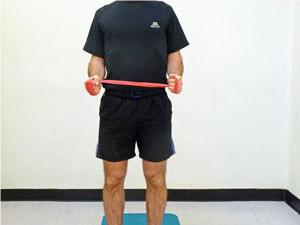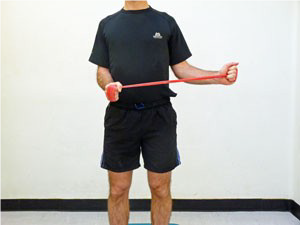What are Therapeutic Exercise Resistance Bands?
Resistance bands are elastic bands used for strength training and rehabilitation following an injury. There are a variety of different resistance bands available which are made to allow stretch of up to 300%. With this strength, they offer different stretch resistance which we can use to strengthen and work the muscles. There are several levels of resistance bands available, they are often colour co-ordinated to match their strength. For example, lighter coloured resistance bands (e.g. yellow bands) tend to offer the least amount of resistance, whereas darker bands (e.g. black bands) offer the most resistance.
Why do we use them?
Resistance bands can be used for several reasons, depending on what you are aiming to achieve. As the bands offer different strengths of stretch, they can be used for certain rehabilitation exercises as part of your therapist led treatment plan as well as part of your normal workout routine.
The lighter bands can be excellent for early rehabilitation to target specific muscles. An example of this is below. This exercise works on the posterior shoulder strength. It uses a medium strength resistance band to target the specific muscles without compensating with other, stronger muscles.
As well as rehabilitative exercises, the stronger resistance bands can be used for more heavy-duty exercises. As you progress through your treatment plan and become stronger, these become more suitable. They are often used for the bigger muscle groups, such as your hip flexors, to provide a larger resistance which the lighter resistance bands could not achieve.
Popular Exercises using Resistance Bands
Internal rotation
External rotation
Step 1: Attach one end of a resistance band to sturdy object about floor level. Grab the other end in your right hand with an overhand grip.
Step 2: Stand tall and bring your right elbow up so that your upper arm is in line with your shoulder. Bend your elbow 90 degrees so your forearm is parallel to the ground. This is the starting position.
Step 3: Begin exercise by rotating your forearm back so that your arm is perpendicular to the ceiling, or until your feel a comfortable stretch in your shoulder. Slowly reverse movement back to starting position.
Row
Crab Walk
Step 1: Place a resistance band just above the knees, above the ankles or around the mid-foot. The band should be tight enough to stay up by itself. The crab walk can be used for a variety of goals. It is often used as a glute activation exercise and a strengthen exercise. A less tensioned band would be more suitable for glute activation, whereas a sturdier band is used for strengthening.
Step 2: Start with the legs around hip width apart, keep your feet pointing straight ahead and slightly bend at the knees – like a half squat position. From here, step sideways with your left leg so it is beyond shoulder width.
Step 3: The next move is to step inwards with the right leg. After this step, both feet should return to the starting position – feet hip width apart and knees slightly bent.
Step 4: Repeat the process by stepping sideways again with the left leg. Continue to do this for 10 steps or 30 seconds.
Step 5: Repeat the same process leading with the right leg.
Your therapist will advise you if a resistance band would complement your treatment or exercise plan and will inform you of which strength/colour band would be most suitable for you.
Resistance bands are available to purchase from our reception desk at our Newcastle City Centre clinic.



